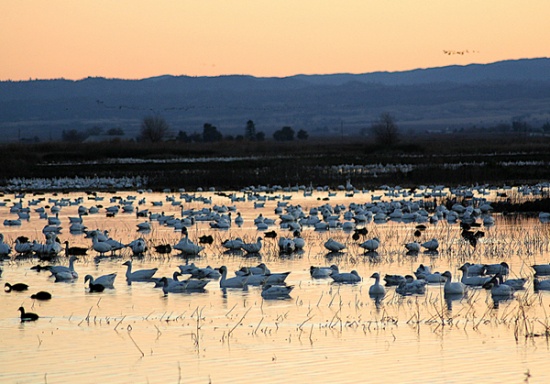| This article is incomplete. This article is missing one or more sections. You can help the BirdForum Opus by expanding it. |

Photo © by ayasuda
Colusa National Wildlife Refuge California January, 2007
Overview
Colusa National Wildlife Refuge is one of six refuges in the Sacramento Refuge Complex located in the Sacramento Valley of north-central California. The refuge is located near Willows, about 70 miles north of metropolitan Sacramento.
The 4,507-acre refuge primarily consists of intensively managed wetland impoundments, with some grassland and riparian habitat. The Sacramento Valley is one of the most important wintering areas for waterfowl in North America. Colusa Refuge typically supports wintering populations of more than 200,000 ducks and 50,000 geese.
Wetland impoundments are intensively managed to provide optimal habitat for the dense concentration of wintering waterfowl, as well as habitat for resident wildlife and spring/summer migrants.
Birds
Notable Species
Thousands of waterfowl are here from September into, and through, March. Expect peak populations here in December and January.
It's a wintering spot for over 200,000 ducks and 75,000 geese.
Wood ducks can be seen nesting year-round. [1]
Colusa has had 291 species reported as spotted and 8 globally threatened species. [2]
Rarities
Species recorded as rare for this location[2] include the Trumpeter Swan, Jack Snipe, and the Cape May Warbler.
Check-list
Birds you can see here include:
Snow Goose, Tundra Swan, Ruddy Duck, Mountain Quail, Ring-necked Pheasant, Pied-billed Grebe, Rock Pigeon, Greater Roadrunner, Lesser Nighthawk, Vaux's Swift, Black-chinned Hummingbird, Virginia Rail, Sandhill Crane, Black-necked Stilt, Black-bellied Plover, Whimbrel, Short-billed Dowitcher, Lesser Yellowlegs, Bonaparte's Gull, Forster's Tern, Common Loon, Double-crested Cormorant, American White Pelican, American Bittern, White-faced Ibis, California Condor, Osprey, White-tailed Kite, Barn Owl, Flammulated Owl, Belted Kingfisher, Yellow-bellied Sapsucker, Northern Flicker, American Kestrel, Western Wood-Pewee, Western Kingbird, Hutton's Vireo, Loggerhead Shrike, Steller's Jay, Mountain Chickadee, Horned Lark, Northern Rough-winged Swallow, Bushtit, Wrentit, Golden-crowned Kinglet, Red-breasted Nuthatch, Brown Creeper, Blue-gray Gnatcatcher, Rock Wren, American Dipper, European Starling, California Thrasher, Western Bluebird, Bohemian Waxwing, Phainopepla, House Sparrow, American Pipit, House Finch, Thick-billed Longspur, Grasshopper Sparrow, Bell's Sparrow, Spotted Towhee, Yellow-breasted Chat, Yellow-headed Blackbird, Great-tailed Grackle, Northern Waterthrush, Wilson's Warbler, Western Tanager.
Other Wildlife
The grassland habitat supports several populations of endangered and sensitive species of plants. The refuge is a stronghold for populations of the endangered palmate-bracted bird's-beak and the threatened Giant Garter Snake.
Site Information
History and Use
To do
Areas of Interest
To do
Access and Facilities
Sacramento International Airport (SMF) is the closest major commercial airport to Colusa National Wildlife Refuge.
Contact Details
To do
References
- Colusa National Wildlife Refuge – US Fish and WildlifeService - https://www.fws.gov/refuge/colusa/
- Lepage D. (2020) Colusa Bird Checklist - Avibase - Bird Checklists of the World. Retrieved 9 September 2020
Recommended Citation
- BirdForum Opus contributors. (2025) Colusa National Wildlife Refuge. In: BirdForum, the forum for wild birds and birding. Retrieved 3 January 2025 from https://www.birdforum.net/opus/Colusa_National_Wildlife_Refuge
External Links
Maps
Content and images originally posted by ayasuda
Reviews
JonLivesay's review LOTS OF GREATER WHITE-FRONED GEESE, NUMEROUS DUCKS, INCLUDING PINTAIL, WIDGEON, TEAL, MALLLARD, COOT, SHOVELER. AMERICAN BITTERN SIGHTED ON 4 DIFFERENT AREAS OF THE DRIVING LOOP. PHEASANTS IN ABUNDANCE, AS WERE RED-TAILED HAWK AND NORTHERN HARRIER. KINGFISHER, AMERICAN KESTRAL ALSO. 3 MILE CAR LOOP TAKES YOU WITHIN A COUPLE OF FEET OF THE PONDS. NOT AS MUCH USE HERE SO BIRDS ARE A BIT SKITISH, YOU MUST DRIVE VERY SLOW AND BE AS QUIET AS POSSIBLE. EASY ACCESS CAN BE A FUN PART OF YOUR BIRDING DAY. Pros
- ABUNDANT BIRDING OPPURTUNITIES
Cons
- CLOSE PROXIMITY TO BIRDS MAKES THEM SKITISH





